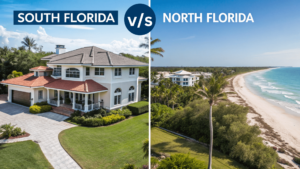For fixed-rate vs. ARM loans for first-time homebuyers, ARMs offer lower initial payments, appealing to those seeking affordability or planning short-term ownership (e.g., 5-7 years) in a starter home. This allows upfront savings or increased buying power. However, ARMs carry the risk of higher payments post-adjustment if interest rates rise and the homeowner stays longer or cannot refinance. Fixed-rate loans provide payment stability, ideal for long-term residents.
Table of Contents
ToggleWhat Is an Adjustable-Rate Mortgage (ARM)?
An adjustable-rate mortgage (ARM) is a home loan with an interest rate that changes over time. The rate is typically lower than a fixed-rate mortgage for a certain number of years, and then it can go up or down based on market conditions.
Structure of an ARM
Most ARMs have two distinct periods:
- Initial fixed-rate period – This is the period when your interest rate is locked in and doesn’t change. Common terms include:
- 5/1 ARM – Fixed for 5 years, then adjusts annually
- 7/1 ARM – Fixed for 7 years, then adjusts annually
- 10/1 ARM – Fixed for 10 years, then adjusts annually
- Adjustment period – After the fixed period, your rate adjusts periodically (usually annually) based on a market index plus a margin.
For example, with a 5/1 ARM, your interest rate stays the same for the first 5 years. Then, beginning in year 6, your rate can change once per year, based on market trends.
Key Components:
- Index: A benchmark rate, like the Secured Overnight Financing Rate (SOFR)
- Margin: A fixed percentage added to the index (e.g., 2.25%)
- Caps: Limits on how much your interest rate can increase (per adjustment and over the life of the loan)
Why ARMs Appeal to First-Time Homebuyers
First-time buyers often face affordability challenges—limited savings for a down payment, student debt, or entry-level salaries. ARMs offer lower starting interest rates, which can translate into significantly lower monthly payments during the early years of the loan.
Example: Comparing a Fixed-Rate Mortgage vs. 5/1 ARM
Let’s say you’re buying a $350,000 home with 10% down, financing $315,000.
| Loan Type | Interest Rate | Monthly Payment (Principal & Interest) |
| 30-Year Fixed | 6.75% | ≈ $2,045 |
| 5/1 ARM | 5.50% | ≈ $1,789 |
Monthly savings: $256
Savings over 5 years: Over $15,000
That’s a meaningful difference—especially for buyers trying to furnish a home, build an emergency fund, or pay off debt.
When an ARM May Be a Good Fit for First-Time Buyers
Choosing an ARM isn’t just about snagging a lower rate. It’s about aligning your mortgage with your life plans. If you’re confident that your time in the home will be shorter than the fixed-rate period, an ARM can be a strategic financial tool.
1. Short-Term Ownership Plans
Do you plan to move in 5 to 7 years? Maybe your job is likely to relocate, or you’re buying a starter home with plans to upgrade later. If so, a 5/1 or 7/1 ARM could save you money without exposing you to rate risk.
2. Stepping Stone Home
Many first-time buyers don’t plan to stay in their first home forever. They expect to start a family, move for a new job, or simply grow out of the space. An ARM aligns well with this short-to-medium-term plan.
3. Expectation to Refinance
If you believe interest rates will fall—or your credit or income will improve—you might plan to refinance within a few years. The lower ARM rate can help you save now and refinance later.
4. Higher Buying Power
Because the initial payments are lower, an ARM may allow you to qualify for a larger loan or better location than you could with a fixed-rate mortgage.
Important: Just because you qualify for more doesn’t mean you should borrow more. Consider your long-term affordability.
When an ARM Might Not Be the Best Choice
ARMs come with risks—particularly for buyers who stay in their home longer than expected or can’t refinance before the adjustment period begins.
1. Uncertain Future Plans
If your timeline is unclear—maybe you think you’ll move in 5 years, but aren’t sure—it may be safer to stick with a fixed rate.
2. Tight Budget
If your budget has no wiggle room, even a modest rate increase could cause financial strain. ARMs come with uncertainty after the fixed period, and rates can rise significantly over time.
3. Potential for Higher Long-Term Costs
While ARMs may offer upfront savings, they can cost more in the long run if rates increase and you stay in the home. This is especially true if you can’t refinance due to job loss, credit issues, or declining home values.
Understanding What Happens After the Fixed Period
Once the initial fixed-rate period ends, your loan adjusts annually based on a specific formula:
New rate = Index + Margin (subject to rate caps)
Rate Cap Structure:
- Initial adjustment cap: Usually 2%
- Annual adjustment cap: Usually 2%
- Lifetime cap: Typically 5% above the initial rate
Example Adjustment:
- Initial rate: 5.50%
- Margin: 2.25%
- Index in year 6: 4.00%
- New rate: 4.00% + 2.25% = 6.25% (within cap limits)
This could increase your monthly payment by hundreds of dollars. That’s why ARMs are best for buyers who are certain they’ll move or refinance before reaching the adjustment period.
When Does an ARM Stop Saving You Money?
A helpful way to evaluate an ARM is to calculate your break-even point—the moment when a fixed-rate mortgage becomes the better deal overall.
To calculate this:
- Determine total savings during the ARM’s fixed period.
- Estimate the payment increase after the rate adjusts.
- Compare the long-term cost to a fixed-rate alternative.
If your break-even point is beyond your expected time in the home, the ARM is likely a good choice. If it’s before, you’re better off with a fixed-rate loan.
Questions First-Time Buyers Should Ask Before Choosing an ARM
- How long do I realistically plan to stay in the home?
- Can I afford a higher monthly payment if rates increase?
- Will I be able to refinance before the rate adjusts?
- How stable is my job, income, and credit situation?
- Am I comfortable taking on some risk in exchange for upfront savings?
Tips for First-Time Buyers Considering an ARM
- Choose the Right Term
- If you’re unsure about a 5-year plan, consider a 7/1 or 10/1 ARM to build in more security.
- Stress-Test Your Budget
- Ask your lender to show worst-case payment scenarios after adjustment.
- Understand All Loan Terms
- Know your rate caps, index type, and adjustment schedule in detail.
- Don’t Stretch Your Budget
- Avoid buying more home than you need just because the ARM offers lower payments now.
- Plan for Refinancing Early
- Maintain good credit and monitor home values so you can refinance if needed before the adjustment period.
Final Thoughts
An ARM can be a powerful affordability tool for the right kind of first-time buyer. If you’re confident in your short-term plans and want to minimize upfront costs, an ARM could help you enter homeownership more comfortably.However, ARMs are not for everyone. If you value long-term stability, expect to stay put, or have a tighter budget, the predictability of a

